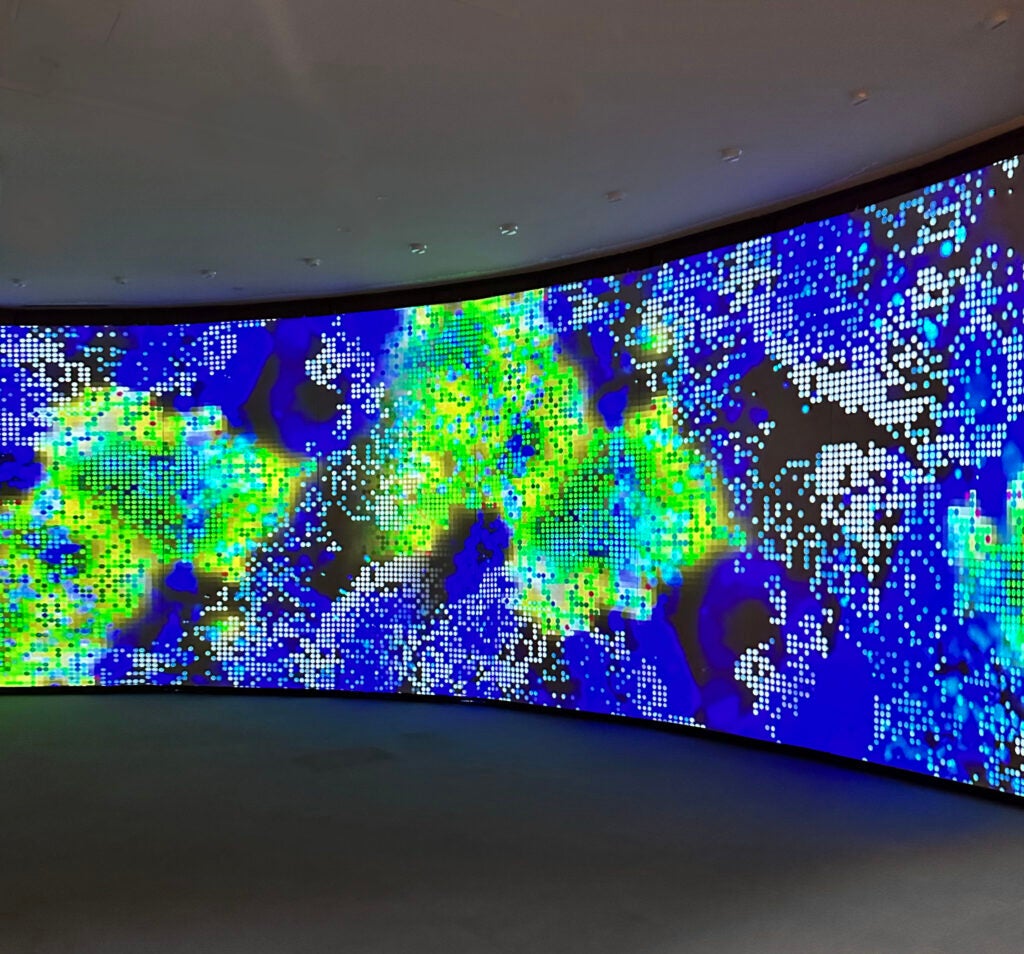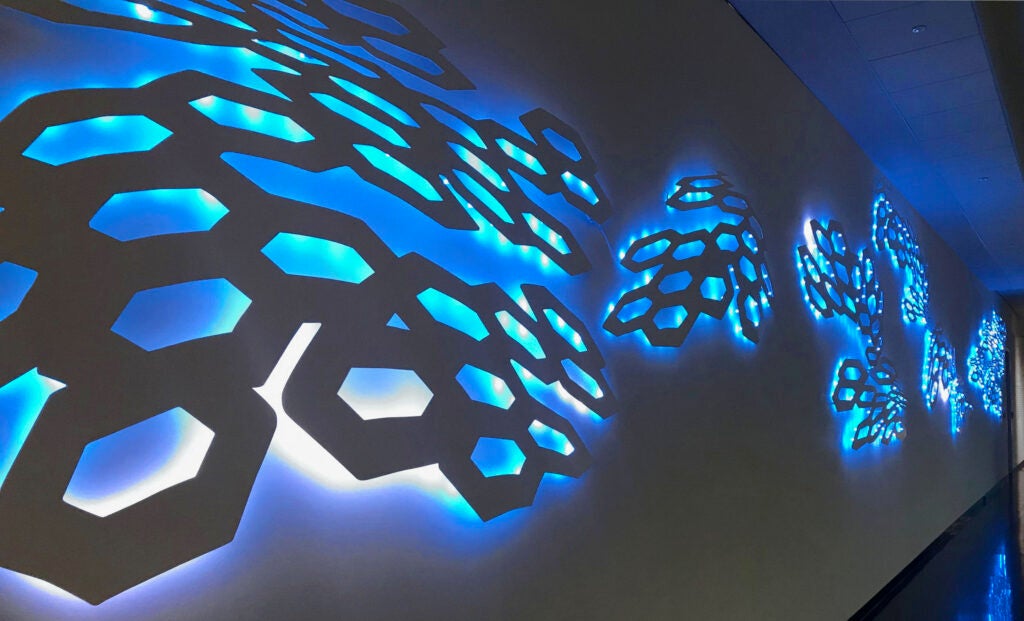The synergy between the arts and the sciences: representing the wonders of the natural world through visual art
A Conversation with visual artist Rebecca Rutstein by Common Home editor Elyza Bruce

Installation photo of Blue Dreams: Rebecca Rutstein and the Ocean Memory Project on view at the National Academy of Sciences thru Sept 15, 2023. Video projection on an 11×35′ custom curved screen, 2023.
Rebecca Rutstein is an interdisciplinary artist whose work, in collaboration with scientific researchers, explores the interconnected systems and unseen wonders of the natural world. You can learn more about her work at rebeccarutstein.com.
Elyza: Most of your work explores subjects of science and the natural world. How did this inspiration start and how has it changed over the years?
Rebecca: I always knew I wanted to be an artist. From a very young age, it was just an integral part of me. My connection to the natural world evolved more slowly over time. I wasn’t brought up in a family that was super outdoorsy. I landed in upstate New York at Cornell University for college, and if you’re not familiar, the Finger Lakes region of New York is a wild display of geologic wonders, with gorges, waterfalls and monumental layers of sedimentary rock. On a whim, I took a geology course which was life changing. For class we would go to nearby state parks and learn about geologic processes firsthand. It wasn’t until after college and beyond grad school that I started thinking about geology as subject matter in my paintings. I was in my twenties with lots of tumultuous relationships and ups and downs. One day I was leafing through a geology textbook in my studio when I came upon these diagrams showing how the earth’s tectonic plates were separating and colliding, and I began thinking about how these forces underneath the surface were causing upheaval. This resonated for me as a metaphor for interpersonal relationships; all of the friction, tension and erosion that happens over time. So I started playing around with this idea of incorporating the diagrams into my paintings. This early experimentation sparked a genuine, lifelong pursuit to learn about the geology of different regions and create visual narratives about them. These explorations and my collaborations with scientists have become one of the most important aspects of my practice as I try to shed light on places and these processes that are often hidden from view.
Elyza: You use a variety of mediums from large sculptures to paintings. Could you break down your artistic process for an average piece from start to finish?
A lot of my recent projects are research-based, where I’m collaborating with scientists. That’s exciting for everyone involved, because we’re not in silos. We’re working together to come up with something that is related to what they’re doing, but also, maybe taking it in a new direction. What’s exciting for me about these interdisciplinary exchanges is that we’re having a real dialogue. Often I hear that scientists look at their work differently after seeing my artistic expression of what they’re doing. So there really is a synergy. If I’m working on a more immersive type installation that involves sculpture and LED lights that are programmed to mimic something in nature, those involve partnerships where I need funding, and there’s a collaborative process where I’m working with other people to realize the project. In the case of a painting, it’s a much more solitary process, that personal relationship between myself and the canvas where I’m exploring and pushing ideas.

Installation photo of Shimmer in the permanent collection of the Georgia Museum of Art. Powder-coated steel, LED lights and motion sensors, 2018.
Elyza: For some of your research, you actually travel with scientists on expeditions. Could you speak on that and whether it changes how you view what you’re trying to represent?
Rebecca: It has been beyond life changing to dive in deep sea submersibles and actually witness with my own eyes this otherworldly universe at the bottom of the ocean. The sensation of moving through the water column, descending slowly for long periods of time in the darkness, and seeing bioluminescent life moving all around you like dancing stars changes your whole perspective on our place in the universe. It’s not only the experience of being in the submersible and seeing these wild chemosynthetic ecosystems at the bottom of the ocean, it’s also the experience of being on the ship and being embedded with the scientists. There’s a synergy that happens on these expeditions. We’re working together, elbowing in the lab together while I’m painting, and they’re working with samples, and we’re discovering and exploring and learning together. Beyond the scientists, it’s also the whole team, the crew, the engineers; everybody’s a family, because you all have to work together to run a smooth ship and to have a successful science operation.
Elyza: In our culture, it always seems like science and art are viewed as polar opposites. Art is all about beauty, emotions and aesthetics while the sciences are based on cold, hard facts and rationalism. Do you ever think about how your work might marry these two seemingly opposite things?
Rebecca: In my experience, they are not opposite at all. I have met scientists who are more creative than artists. Every collaboration I’ve had with scientists corroborates this for me: scientists and artists are in fact very similar in that we are both interested and inquisitive about the world. We’re keen observers and trying to make sense of the world around us. And there’s a shared passion, you know? I always joke that scientists and artists are both grossly underpaid, so you have to really love what you do to do it. In terms of how my work might marry these seemingly opposing forces, I do believe there are these juxtapositions present in my work; expressive and emotionally charged moments that are grounded in patterns and systems observed in the natural world.
Elyza: What do you hope viewers will take away from your work?
Rebecca: I think about this a lot. I’m interested in creating work that is a visceral experience for the viewer that can be appreciated on a formal level, and that can generate moments of wonder, joy, curiosity, or what have you. Taking it further, I am interested in the piece resonating beyond aesthetics where the viewer might learn something new about the natural world. That might happen through seeing patterns that they recognize or by reading wall panel text where I describe the inspiration for the work. I would hope a viewer might take away a deeper understanding for the complexities of the natural world, a reverence and an empathy for these systems, and hopefully, a feeling of connection to foster a sense of stewardship for the natural world. That’s really, for me, what it’s about.
***
Rebecca’s project “Blue Dreams,” an immersive video installation, will be showing at the National Academy of Sciences in Washington, D.C. from March 15-September 15 as part of the Ocean Memory Project. Rebecca will be speaking on a panel during the closing reception for Blue Dreams on September 7, 2023. You can register for the event here.
Note: Minor edits have been made for clarity and concision.
